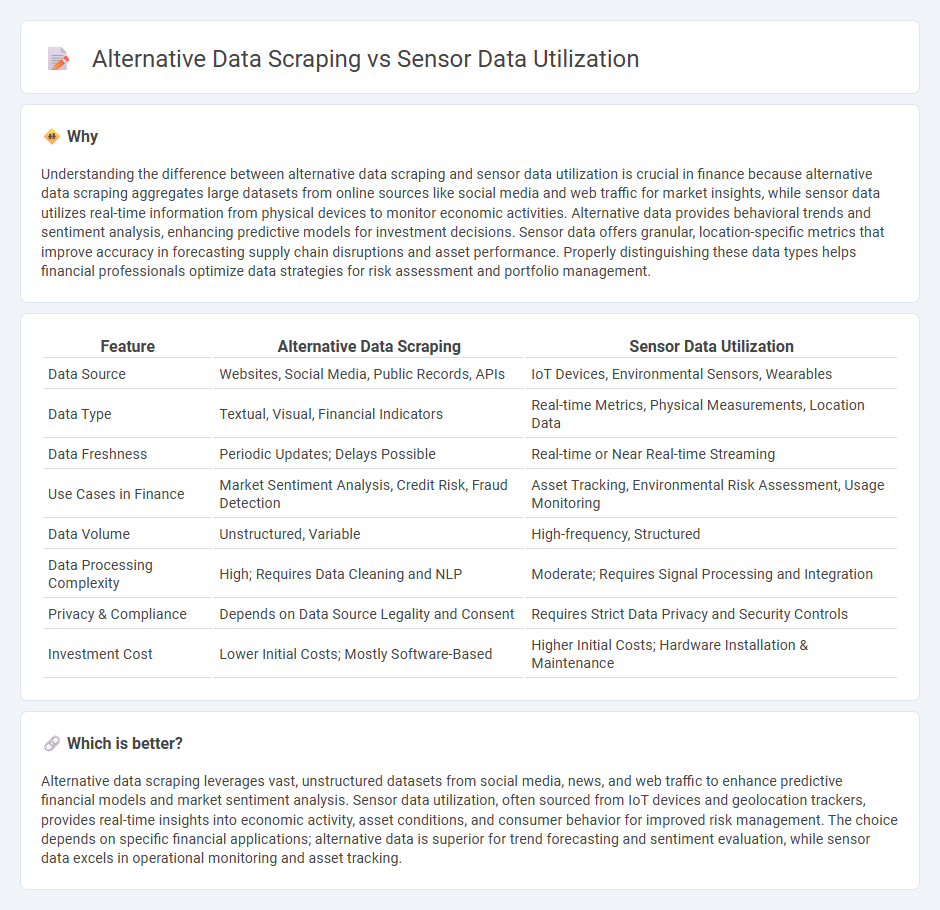
Alternative data scraping involves extracting information from unconventional sources like social media, satellite imagery, and web traffic to gain unique financial insights. Sensor data utilization leverages real-time inputs from IoT devices, GPS trackers, and environmental sensors to enhance predictive analytics and market trend analysis. Explore the evolving impact of these technologies on financial decision-making and investment strategies.
Why it is important
Understanding the difference between alternative data scraping and sensor data utilization is crucial in finance because alternative data scraping aggregates large datasets from online sources like social media and web traffic for market insights, while sensor data utilizes real-time information from physical devices to monitor economic activities. Alternative data provides behavioral trends and sentiment analysis, enhancing predictive models for investment decisions. Sensor data offers granular, location-specific metrics that improve accuracy in forecasting supply chain disruptions and asset performance. Properly distinguishing these data types helps financial professionals optimize data strategies for risk assessment and portfolio management.
Comparison Table
| Feature | Alternative Data Scraping | Sensor Data Utilization |
|---|---|---|
| Data Source | Websites, Social Media, Public Records, APIs | IoT Devices, Environmental Sensors, Wearables |
| Data Type | Textual, Visual, Financial Indicators | Real-time Metrics, Physical Measurements, Location Data |
| Data Freshness | Periodic Updates; Delays Possible | Real-time or Near Real-time Streaming |
| Use Cases in Finance | Market Sentiment Analysis, Credit Risk, Fraud Detection | Asset Tracking, Environmental Risk Assessment, Usage Monitoring |
| Data Volume | Unstructured, Variable | High-frequency, Structured |
| Data Processing Complexity | High; Requires Data Cleaning and NLP | Moderate; Requires Signal Processing and Integration |
| Privacy & Compliance | Depends on Data Source Legality and Consent | Requires Strict Data Privacy and Security Controls |
| Investment Cost | Lower Initial Costs; Mostly Software-Based | Higher Initial Costs; Hardware Installation & Maintenance |
Which is better?
Alternative data scraping leverages vast, unstructured datasets from social media, news, and web traffic to enhance predictive financial models and market sentiment analysis. Sensor data utilization, often sourced from IoT devices and geolocation trackers, provides real-time insights into economic activity, asset conditions, and consumer behavior for improved risk management. The choice depends on specific financial applications; alternative data is superior for trend forecasting and sentiment evaluation, while sensor data excels in operational monitoring and asset tracking.
Connection
Alternative data scraping captures unconventional financial indicators from online sources, while sensor data utilization provides real-time environmental and behavioral insights. Combining these methods enhances predictive analytics by integrating diverse datasets such as social media trends, transaction records, and IoT sensor feeds. Financial institutions leverage this synergy to improve risk assessment, market forecasting, and investment strategies.
Key Terms
Data Acquisition
Sensor data utilization leverages real-time, machine-generated readings from devices such as IoT sensors, GPS trackers, and industrial equipment, offering high accuracy and continuous data streams essential for predictive analytics and operational monitoring. Alternative data scraping involves extracting unstructured data from public websites, social media platforms, and other digital sources, providing rich behavioral and sentiment insights but often requiring extensive cleaning and validation. Explore deeper insights into the advantages and implementation challenges of both data acquisition methods to enhance your data strategy.
Signal Generation
Sensor data utilization harnesses real-time, precise inputs from devices such as IoT sensors, wearables, and industrial equipment to generate accurate, actionable trading signals. Alternative data scraping involves extracting unstructured information from web sources like social media, news feeds, and satellite imagery, which requires advanced processing techniques to convert into predictive signals. Explore the evolving methodologies to optimize signal generation for enhanced trading strategies.
Predictive Analytics
Sensor data utilization offers real-time, high-precision inputs crucial for predictive analytics models across industries such as manufacturing, healthcare, and transportation. Alternative data scraping collects diverse, unstructured data like social media trends and web behavior to enhance forecasting accuracy through enriched contextual insights. Explore how integrating both data sources can revolutionize predictive analytics performance in your field.
Source and External Links
Navigating Sensor Data Analytics | Expert Guide - Sensor data utilization involves collecting, preprocessing, analyzing, and integrating sensor data to derive actionable insights that improve business operations, enhance real-time monitoring, and enable predictive modeling for future event forecasting.
Sensor Data: What Is It & How to Use It? | InfluxData - Sensor data represents continuous time series data generated from devices detecting environmental inputs, such as temperature, humidity, pressure, and motion, which are widely used across industries and IoT applications to monitor and respond to physical conditions.
Sensor Data: How to Utilize Effectively - HVI Community - Effective utilization of sensor data requires data collection, cleaning, analysis to detect patterns and anomalies, enabling predictive maintenance, real-time alerts, customizable reports, and seamless integration to optimize operations and manage sensor data challenges like data overload and accuracy.
 dowidth.com
dowidth.com